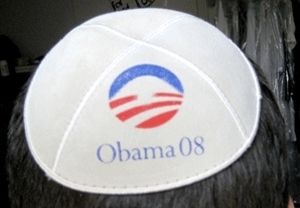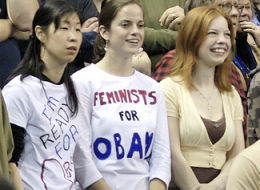SANTA ANA, Feb. 3: The Obama campaign, intent on taking some of the crucial Latino vote in California away from Hillary Clinton, organized a daylong door-to-door canvas on Saturday in the region’s most Spanish-speaking city just south of Disneyland.
200 volunteers showed up for a morning rally in Santa Ana before heading out for the final push to canvas their precincts. The tote board in the streetfront Obama office showed 51 precinct captains had already logged almost 8,500 calls.
The LA Times poll last week had Obama getting under 30 per cent of the state’s Latinos in the primary, while Hillary was at 60 percent.
Santa Ana is the most Spanish-speaking city in the US. In 2006 it became the largest US city with an all-Latino city council. Santa Ana is also a city where the mayor, Miguel Pulido, has endorsed Hillary; where the representative in congress, Loretta Sanchez, has endorsed Hillary; and where Hillary herself campaigned in December with Latina icon Dolores Huerta.
Nevertheless the Obama effort in Santa Ana is big, well-organized and energetic. At the rally, office staffer Abraham Jenkins asked how many of the 200 volunteers had worked in previous campaigns. A few hands went up. Then he asked, “How many are first timers?” Almost everybody raised their hands.
The headliner at the rally was Congressman Xavier Becerra from L.A., one of Obama’s highest profile Latino supporters. He recalled that Bobby Kennedy campaigned as an underdog in the California primary in 1968, and brought a new kind of hope to voters. “Someone stole that from us in 1968,” he said; “someone tried to snuff out the light. But 40 years later, we have that spark again.”
He told the precinct walkers the key arguments to make when they knocked on Latino doors: At the top of the list: “Obama is the son of an immigrant.” Second: “Obama is a Harvard law grad who went to work as a community organizer.” Then “tell them to read La Opinion, which today endorsed Obama;” and “tell them why this is your first time working in a campaign – why you are doing this.”
The enthusiasm and energy of the first-timers was unmistakable, but it didn’t solve the big problem facing the Obama operation in Santa Ana: the precinct walkers were a largely white group in an overwhelmingly Latino city. When staffers asked how many of the 200 volunteers were bilingual, perhaps a dozen raised their hands.
One of those was Elvira Rios, a precinct captain, a retired schoolteacher and a “first timer.” Her perspective on Latino voters is radically different from what you get in the media. “The biggest challenge is not getting them to switch from Hillary to Obama,” she said. “The biggest challenge is getting them to vote at all.”
She said she has been working in Santa Ana for Obama for the last ten days from nine to nine, and only a week ago she had to start with the basics: “voters needed to hear his name – many didn’t really know his name.”
The biggest Clinton supporters among Latinos, she said, are “the mothers.” But “it’s amazing how many young Latinos were trying to talk their parents into voting for Barack. I see this all the time.”
Were the kids succeeding? She shook her head no: “Older Latinos,” she said emphatically, “are so stubborn.”
Unlike Elvira Rios, the great majority of Obama volunteers in Santa Ana were young Anglos who didn’t speak Spanish. Several were students at nearby UC Irvine. Rebecca Westerman is one – she lives in Santa Ana and is an Obama precinct captain for her Latino precinct. She told me that she has reached one-third of the 800 voters on her list. “I’m focusing on the 18-25 year olds,” she said, “because that’s where we’ve gotten a good response.”
Mark Hendrickson is a recent grad of UC Irvine and another Santa Ana resident and precinct captain. In his canvassing, he said, “I get mostly Spanish speakers, but I don’t speak Spanish.” As the two of them were about to head out, the office staff was trying to find bilingual partners for each of them; they found one woman volunteer from the neighborhood – she was wearing a UNITE-HERE T-shirt — but she had to go to work. So the two went out to canvas by themselves, full of youthful energy and hope.
Five hours later, Westerman reported that “We actually had a really good response from our entirely Latino precinct. Suprisingly, more people were already supporting Obama than Clinton – and our limited Spanish got us a long way.”
To be a campaign veteran in this operation is to have worked in Obama’s Las Vegas effort a couple of weeks ago, which several people had done. Two staffers had worked for several months in Iowa. As for people with campaign experience before that, the only one was Jocelyn Anderson, a paid regional field director who is African American. She had volunteered for the Clinton campaigns in 1992 and in 1996, the first in Alabama and the second in Michigan.
Asked her how the Obama effort compared to those, she said “This is more than a campaign. It’s a movement. The least of it is the policy issues. Obama is moving people to change the world.” She added, “Hillary is a great candidate, but Obama is the first time you don’t have to vote the lesser of two evils.”
Only a few Latinos from the neighborhood showed up for the rally. Afterwards, one young Latino couple with two children introduced themselves to Congressman Becerra, and the man explained why he was supporting Obama: “I have older cousins lost to the war, and I don’t want my kids. . . .” his voice trailed off. “I know,” Becerra said quietly. “Thank you for coming today.”
The energy of the 200 volunteers in Santa Ana on Saturday was real; their passion was palpable. But the election was only three days away. How much success could this effort have in winning Latino votes for Obama? Nobody in the office would hazard a guess; Giovanii Jorquera, community outreach director, said quite honestly, “we’ll see on Tuesday.” Congressman Becerra summed it up best: “if people only had a little more time to get to know him.”
 March 2: Now it’s official: page one of the New York Times reported on Saturday that the Jews have a problem with Obama.
March 2: Now it’s official: page one of the New York Times reported on Saturday that the Jews have a problem with Obama.
